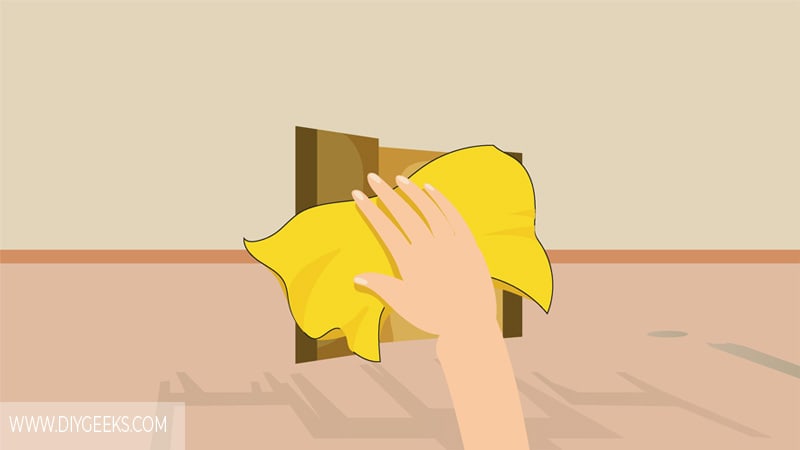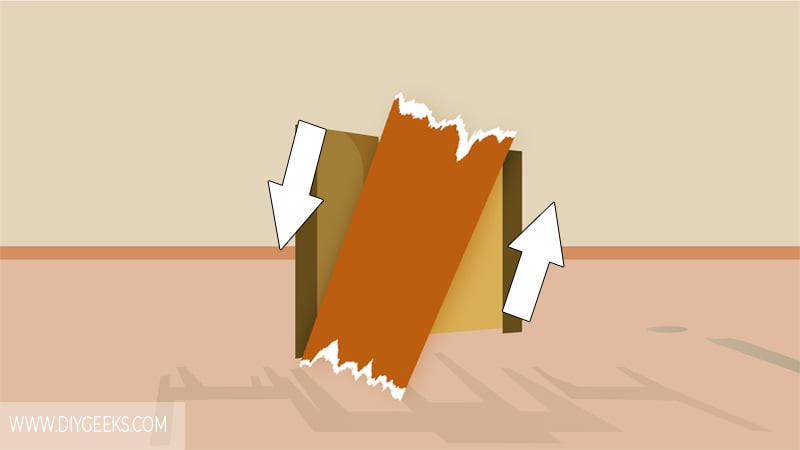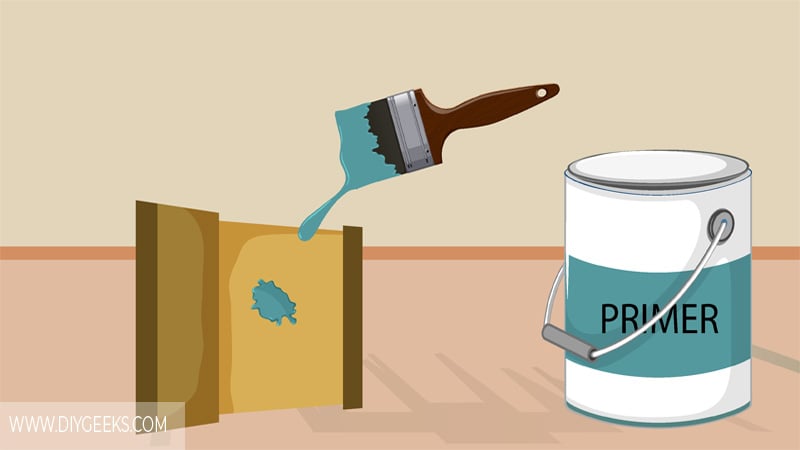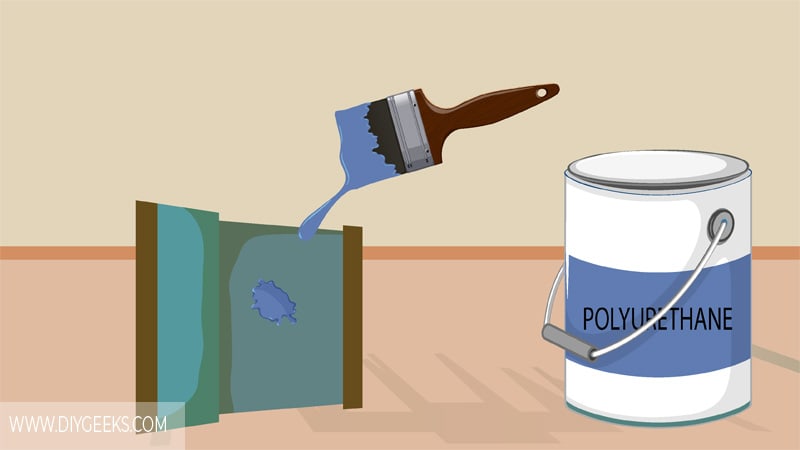You can apply polyurethane over a plastic surface, but you must prep the surface by cleaning, sanding, and priming. Plastic is non-porous and has a slick surface, so polyurethane won’t adhere well directly over it.
To apply polyurethane over plastic, clean the plastic surface, sand the surface, apply primer, apply polyurethane, and dry the finish.
For outdoor plastic surfaces, use exterior polyurethane as it’s formulated with UV-blockers and will protect the surface from outdoor weather elements.
Does Polyurethane Adhere to Plastic?
Polyurethane does stick to plastic, but the adhesion won’t be good as plastic is a non-porous material with a slick and impermeable surface.
Polyurethane is a topical sealer – meaning it doesn’t need to penetrate a surface to stick. But, since plastic has a slick surface, the sealer will slide off the surface when applied. Since polyurethane can’t penetrate (just a bit) or stay in the same position, it won’t stick.
You must sand or apply primer to the plastic surface to improve the adhesion. Sanding will create tiny ridges (or holes) on the surface that the polyurethane can soak into and adhere to.
A primer coating will create a textured undercoat for the sealer to stick to. So, polyurethane will stick over the primer coating instead of the slick nature of the plastic.
Polyurethane will stick over a painted plastic surface because it will adhere to the paint coating and not the slick surface.
Do You Need To Prime Plastic Before Applying Polyurethane?
You must prime plastic before applying polyurethane to create a textured undercoat for the sealer to stick to. Since plastic is non-porous and slick, a sealer won’t stick well directly over it.
Paint primers are formulated with extra bonding additives that help them to adhere well to different surfaces, including slick plastic. Since primer sticks to the plastic surface, it will create a base layer (undercoat) for the polyurethane to stick to.
But, the paint primer will cover the original color of the surface and the finish will have the same color as the primer since polyurethane is a clear finish (has no pigments).
If you want the surface to have a different color, use pigmented (colored) primers or apply one coat of paint after the primer dries, and then apply the polyurethane.
How To Apply Polyurethane On Plastic?
To apply polyurethane on plastic, do the following.
- Clean the Plastic Surface.
- Sand the Surface.
- Apply Primer.
- Apply the Polyurethane.
- Dry the Finish.
The tools you need for this project are listed below.
- Sandpaper or sanding block.
- Oil or water-based primer.
- Rubbing Alcohol or Dish Soap.
- Paintbrush or Spray Gun.
- Hair Dryer.
1. Clean the Plastic Surface

Clean the plastic surface with rubbing alcohol to remove dust, dirt, or debris that can show once the polyurethane coating is applied and dries. You can use soapy water instead of rubbing alcohol.
Ensure to rinse the plastic surface with soapy water and allow it to dry completely before applying polyurethane.
2. Sand the Surface

Sand the plastic surface with fine-grit sandpaper (220-grit) to remove surface imperfections and bumps, and create tiny pores (holes) that the polyurethane coating can penetrate and adhere to.
Don’t use sandpaper with less than 100 grit as it can scratch the plastic surface.
3. Apply Primer

Apply two (2) primer coats over the plastic surface using a paintbrush or sprayer. The primer coating adheres over the plastic surface and creates an undercoat that can help polyurethane adhere better.
Primers are formulated with extra bonding additives and can adhere to different surfaces, including slick and non-porous surfaces.
Note: The primer coating will cover the plastic surface color shade, and the finish will have the same color shade as the primer. If you want to get a clear finish, don’t apply primer.
4. Apply the Polyurethane

Apply three (3) thin polyurethane coats over the plastic surface using a paintbrush or sprayer. Wait until one coat dries, sand between polyurethane coats, and apply the next coat.
5. Dry the Finish

Use a hairdryer (for 2-3 minutes only) to speed up the polyurethane dry and cure time. The hairdryer increases the heat around the coating which makes the solvent evaporate faster and the finish dry faster.
How Long Does Polyurethane Take To Dry on Plastic?
Water-based polyurethane takes around 6-8 hours to dry enough for a re-coat and 24 hours to cure, while oil-based poly takes around 24 hours to dry between coats and 48-72 hours to cure.
For polyurethane to dry, its solvent (water or oil) must evaporate. Since water evaporates faster than oil, the water-based type dries faster than the oil-based type.
For the sealer to cure, the paint particles must harden and bond together. The polymerization process happens after evaporation.
Polyurethane dries faster on plastic than on any other surface. That’s because it doesn’t penetrate its surface deeply, meaning the evaporation process starts immediately after you apply the sealer. Since the evaporation process starts sooner, the finish dries faster.
Its drying time also depends on the surface conditions. For example, if you apply it over a filthy or dusty surface, it will remain tacky for several days before it dries. So, you must always clean the surface before sealing it.
Other factors that influence the drying time are room temperature, weather, moisture content, number of coats, and thickness.
Can You Use Polyurethane On Outdoor Plastic?
You can use exterior polyurethane on outdoor plastic as it is formulated with UV resistance additives and is durable for outdoor weather elements.
Outdoor plastic surfaces are exposed to rain, water, dust, and heat. All of these factors will damage and discolor its surface. So, you must seal it with an exterior sealer, to prevent it from getting damaged.
When dry, exterior polyurethane forms a glossy layer resistant to water, moisture, scratches, and UV rays that protects the surface underneath from all these elements.
However, you must clean, sand, and prime the outdoor surface before sealing it


